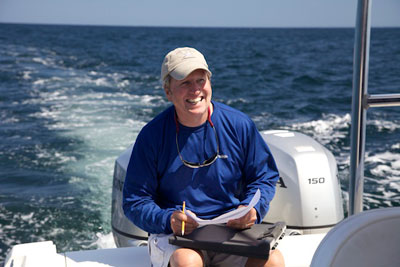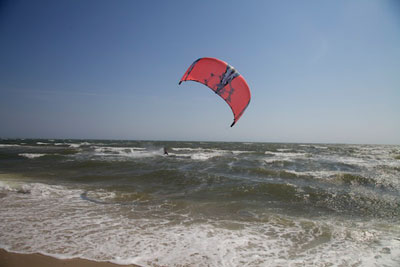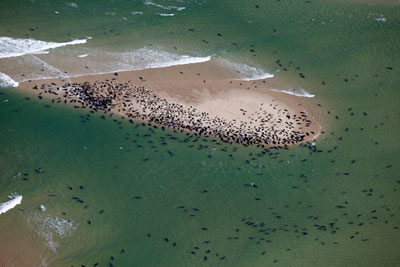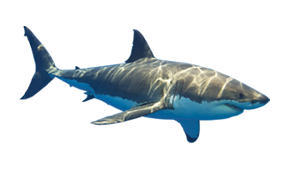The Great White Shark Scientist
(Scientists in the Field Series)
HMH Books for Young Readers, ISBN 978-0544352988
Chapter 1
Carefully avoiding shifting sandbars, captain John King pilots his 24-foot powerboat Aleutian Dream though the shallow, six-foot-deep channel of murky green water at Cape Cod’s Chatham Inlet. “It’s pretty treacherous right here,” says Greg Skomal, a 52-year-old biologist with the Massachusetts Division of Marine Fisheries. But Greg’s big smile, flashing bright as the reflection of sun on waves, shows he’s relishing the adventure.
Though the National Weather Service just lifted its small craft advisory an hour ago, it’s still pretty rough. But Greg’s not scared of the 30-knot gusts of wind, the bucking boat, or getting stuck on a sandbar. He’s got only one concern today. While in the thriller film Jaws, shot not far from Chatham on Martha’s Vineyard, everyone worried about seeing a great white shark, Greg is worried about the opposite. He’s worried about not seeing one!

Greg is a shark biologist—a job he knew he wanted since 8th grade, having grown up on Long Island Sound, watching Jacques Cousteau’s adventures on TV. In Greg’s 39 years on the job, he’s always had plenty of sharks to study. New England’s waters host two dozen species of sharks, from the strange-looking, schooling scalloped hammerhead to the spiny dogfish, a small shark fished here mainly to ship to England for fish n’ chips. But only recently—within the last decade–Cape Cod’s marine ecology has dynamically changed. Now, each summer, just as the beachgoing season begins, the Cape’s cool waters are attracting new visitors: the most powerful, storied and mysterious of all sharks—sharks who are also the most misunderstood.
“Great whites are not at all what people say about them,” Greg stresses. “They’re not hyper, all curmudgeonly and angry and wanting to kill something. They’re not like that at all! I’ve never met one like that. They’re laid back. They’re calm. They’re beautiful.” In fact, great whites are Greg’s favorite sharks. And now, finally, he has a chance to study them–practically in his own backyard.
This season, with a team of volunteers, he’s beginning a new study of the shark population off Cape Cod. His plan calls for eyes both on the sea and in the sky. Working with a spotter plane flying over head, Greg hopes to locate great whites, and then get close enough by boat to take video of them so he can identify individuals. “Ultimately,” he explains, “the goal is to determine who’s out there, and whether we’ve seen them before. The more we know about individuals, the better. We need to spend time getting the demographics of the population, such as male or female, size and age.”
How many great white sharks are swimming off Cape Cod’s famous beaches? Maybe more than most people think. Though in recent summers, sightings have prompted beach closings several times a season, Greg thinks that great whites could be harmlessly passing near busy beaches remarkably often, unseen and unsuspected. Greg estimates his study will take three years to find out.
But studying great whites isn’t easy–especially on a day like today.
“Chatham Inlet is a pretty dangerous area on a normal day,” Greg tells us. “And this isn’t a normal day!” To even attempt to find great whites, the weather has to be good enough so that both the spotter plane and the boat can go out. Wind, rain and fog will scuttle an outing. Waves make the job harder: they crinkle the water’s surface and stir up sand from the bottom. “You can be right over a shark and not see it,” Greg says. And when a shark is spotted, waves like those today make it difficult to keep the animal in view–and exceptionally difficult to film it.
But according to the weather forecast, today may be our best shot all week. We had hoped to go out Monday, but the winds were too high. Flags, awnings and Fourth of July bunting snapped and billowed on shore, whipped by 22-miles-per-hour winds. Conditions were perfect only for kite-surfers. By the end of the week, the forecast was for weather even worse.

So on this Tuesday morning in early July, Greg had resolved to try again. At Chatham’s fish pier, he had gathered today’s team: Skipper John King, and his wife Pam, who live here in Chatham; Cynthia Wigrin, the founder of the Atlantic White Shark Conservancy, which funds Greg’s great white shark work; and Jeff Kneebone, who was a student of Greg’s at University of Massachusetts when he was working on his Ph.D. on sand tiger sharks. So that I could write this book for you, they let me come along, with photographer Keith Ellenbogen to take these pictures.
John gives the safety briefing: Life jackets are located on the starboard (on the right when facing forward; “port” means on the left ) compartment. He points out the two fire extinguishers on board. Only three people are allowed on the observation platform above. “And when we are working on a shark, do not stand right in front of me,” he cautions—because then the captain can’t see. “We’ll try to get back by 3. Drink water. If you have sunscreen, put it on.”
The good news is, despite the wind, the spotter plane has managed to take off. At 9 a.m., pilot Wayne Davis had texted Greg with the news: Flying at 1,200 feet in his light single-engine, two-seater Citabria (spelled backwards, that’s “airbatic” to showcase a plane as agile as an acrobat) Wayne saw a nine-foot great white about a quarter mile off the beach, in eight to ten feet of water. “We might as well mobilize and give it a shot,” Greg decided. So in spite of the weather, we set sail at 10:15 a.m. We’ll head south and west toward Monomoy Island, until we get more news from Wayne. “It’s ugly out,” Greg said, “but we might as well go out there and try.”
Studying great white sharks is tough on even a calm day. These powerful fish can be remarkably shy. They spook easily. In order to get the kind of video Greg needs—clearly showing the shark’s entire body, including both sides and bottom—John will have to maneuver the Aleutian Dream expertly, coordinating with Wayne’s instructions from the air. And on board the boat, Greg will have to keep even with his subject, holding the video camera steady at the end of a long pole stuck in the water.
Each shark looks different. Some have distinctive scars or notches on the dorsal fin or elsewhere on the body. But these features change as a shark ages and acquires more injuries—as one is apt to do if everything you eat, you must first kill with your face. What always stays the same on a great white, Greg explains, is the individual pattern along the shark’s left and right sides, where the dark upper, or dorsal, surface meets the white underparts—especially around the “chin,” gills, and base of the tail. But the team needs to get footage beneath the shark, too. The only way to tell the sex of a mature shark is to check under the tail. A male will have two long, trailing cylindrical organs called claspers; a female will not.
Capturing all this on film, admits Greg, “presents massive logistical issues. But we’re good at overcoming these things,” he says with another big smile. “We think of them as challenges.”
These are challenges everyone seems eager to meet. Kings love sharks so much that not only do they let Greg borrow their Aleutian Dream; John has specially modified it for Greg’s study. They’ve outfitted their boat with a “pulpit”—a slender, gangplank-like metal platform with a metal railing, so that Greg can stand or even lie on his belly just feet above a shark to videotape it, or attach a telemetry tag to its dorsal fin. “John’s boat is a new boat for us,” Greg explains. In the past, they’ve used a commercial harpoon fishing boat as well as some of the state’s smaller vessels. “We’re still sorting out the methodology,” Greg explains shouts over the motor while we cling to the railings and the boat gallops over the chop.
Finally, John slows down so Greg and Jeff can ready the gear. Using electrical tape, they affix an underwater GoPro camera, used for extreme action videography, to a lightweight aluminum pole normally used to extend the reach of house painters. Three other GoPros will be mounted directly on the boat to film the shark from above. “It’s fun,” says Greg, “to figure out what might work.”
Now seems a good time to check in with Wayne again on the radio. Typically, the pilot flies a regular route for Greg looking for seals and sharks from south to North, to the tip of Cape Cod. “I’ve made a few passes,” he says. “Visibility is surprisingly good. It could be better, but it’s not bad.” He’s seen no sharks since that first one, though he’s still looking.
At 11:15, we approach Monomoy Island, an eight-mile spit of roadless, sandy land off the mainland. “Look at all those rocks!” says Keith, marveling at what look like the hundreds of dark boulders on the beach. “Those aren’t rocks,” says Greg. “Those are seals—lots of seals!” Cynthia, Jeff and Pamela set to counting them. It looks like there are 250 just in this one group. “The sharks eat everything,” explains Greg, “but it’s these seals that’s drawing them to the Cape.”

Gray seals, once abundant in New England waters, had been all but exterminated here, victims of bounty hunters who killed them, believing (incorrectly, scientists now confirm, by analyzing seals’ stomach contents) that they competed with fishermen for their catch. (Seals mostly eat sand eels, which fishermen ignore.) But thanks to the Marine Mammal Protection Act of 1972, the seals have staged a comeback. From a few dozen gray seals first spotted in the early 1990s, the Cape’s population has grown to more than 15,000. And their favorite “haulout,” where they leave the water to rest, sun and reproduce, is here on Monomoy.
The Cape gets three other species of seal visitors, but the gray seals—misnamed, as only the females are mottled with grey; the males, weighing up to 800 pounds, are jet black—are favorites of adult great whites. Greg calls these marine mammals “Scooby snacks.” A single seal, with loads of nutritious blubber, might satisfy a great white’s appetite for more than a week.
Though some swimmers might be alarmed to know great whites are swimming close to tourist beaches, they come here to eat the seals, not the people. Great whites aren’t man-eaters, Greg stresses. “More people are injured by their own toilets than by great white sharks!” he points out. (Think about it: tiny children can fall into the bowl and drown; you can slip on a wet bathroom floor and bonk your head on it; there is even a theoretical risk that your toilet could explode!) Great whites rarely hurt humans. In U.S. waters, there have been only a little over a hundred unprovoked great white shark attacks in the past century—averaging only one a year. Fewer than 15 were fatal. By contrast, more than 200,000 Americans are injured in toilet-related accidents each year.
Still, a bite from a shark is no fun—especially if the shark in question is someone who can grow 20 feet long, with 300 razor-sharp, serrated teeth capable of severing an 800-pound seal’s head in one chomp. But this makes it all the more remarkable that most of the few people bitten by great whites survive. Because when this shark discovers its mistake—that it’s bitten a human and not a seal—it almost always spits the person out: Pthh!
A visitor from Colorado discovered this first hand when he was bitten on the leg in July 2012 off the Cape’s Ballston Beach in the town of Truro. He was swimming more than 100 yards out from shore and was near some seals. Though the wound was serious and bloody, the shark only bit once, and the man swam back to shore, unhappily but unassisted. Within six months, his injured leg had healed so well he was back to biking and running.
That was the first great white shark attack on a person in Massachusetts in 76 years. Greg doesn’t want to see more. That’s one reason his work is so crucial. “Knowing more about this species will help protect human beings,” says Greg. “We could really get a sense of when sharks are around beaches and when they’re not.”
But equally important, says Greg, is that his work will benefit the great white sharks themselves. Nobody knows how many great whites remain, but scientists agree that shark numbers worldwide are dropping alarmingly, as people catch them for their fins and teeth, for trophies, and sometimes kill them out of sheer ignorance and spite.
“I want these animals to survive,” says Greg. “They control the balance of the ecosystem.” Great white sharks are apex predators—carnivores with no natural predators of their own. They directly affect the creatures on which they feed, and thus the creatures that feed on their prey, all the way down the food chain. In Australia, for example, researchers found that a sharp decrease in the shark population caused an increase in the kinds of fish that the sharks usually preyed upon—who then ate so many algae-eating, smaller fish that algae began to smother the coral reefs. And on the U.S. east coast, a 2007 study found that 35 years of large shark decline lead to increases in the number of rays and smaller sharks—including cownose rays, which ate so many scallops that the scallop fishery collapsed. And since scallops filter debris from sea water, even the quality and clarity of the seawater suffered as well.
Discovering great whites’ many secrets will be essential to protecting the health of the oceans. “And in order to put in place the rules and regulations that allow for the survival of this species,” says Greg, “we really need to know about the animal and how it lives from day to day.”
Greg carefully notes the number and location of the seals on his sightings form. How does the behavior of seals correlate with the behavior of sharks? This is just one of the questions he hopes his studies will eventually answer. He scans the seals with binoculars. “If we see shark bites, Jeff and I will man the GoPro poles and see what we get,” he says. But the two wounded seals he finds weren’t hurt by sharks. They have gillnets stuck on them, possibly dooming them to lingering deaths. “People try to rescue them, but it’s hard to do,” he says, shaking his head. The seals always flee from their rescuers. “Better to be eaten by a shark.”
By the time we reach the tip of Monomoy, it’s 12:30, and fog begins to roll in. “It happens quick on these parts,” Wayne’s voice crackles on the radio. “I’m going to have to land.”
“We don’t have sky power,” Greg sighs, “so we might as well head in, too.” He’s frustrated, but remains optimistic. “We’re doing pioneering stuff. We never had predictable access to white sharks in the Western North Atlantic—and because of all these seals out there, now we do.
“The complications come from factors we can’t control,” he explains. “Weather. Sharks…” And there’s another complication, too: the sharks leave the Cape in the autumn. That means, says Greg, “we have to smash a whole year’s worth of study into just two months”—July and August.
Happily, the summer’s still young. “I know the sharks are out there,” Greg promises as John docks the Aleutian Dream back at the Chatham fish pier. “All we have to do is find them.”

